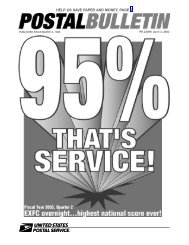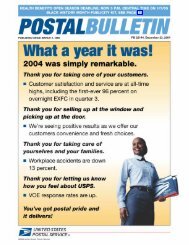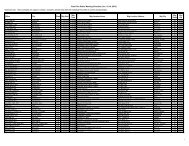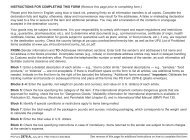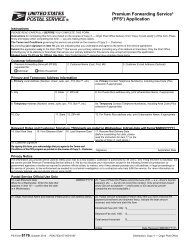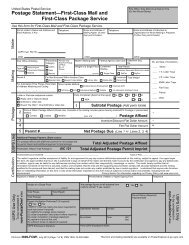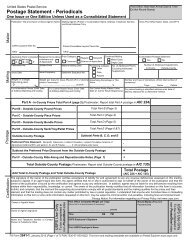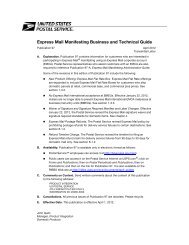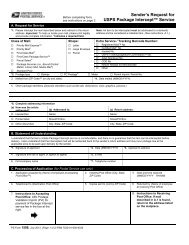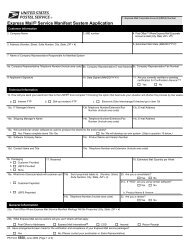Publication 248 - The Perfect Bundle - USPS.com
Publication 248 - The Perfect Bundle - USPS.com
Publication 248 - The Perfect Bundle - USPS.com
Create successful ePaper yourself
Turn your PDF publications into a flip-book with our unique Google optimized e-Paper software.
<strong>The</strong><br />
<strong>Perfect</strong><br />
<strong>Bundle</strong>
What is a bundle?<br />
A bundle is a group of addressed mail pieces that a mailer assembles<br />
and secures together before mailing. <strong>The</strong> individual pieces in a bundle are<br />
presorted for delivery to a specific area. <strong>Bundle</strong>s of flat-size mail pieces are<br />
secured with banding, shrink-wrap, or a <strong>com</strong>bination of the two. Banding may<br />
include clear plastic bands, rubber bands (for lighter bundles), or string that<br />
maintains enough tension to keep the bundle intact during processing. Wire<br />
or metal banding is not permitted. <strong>The</strong> address block on the bundle —<br />
containing all address information, including the optional endorsement line<br />
and any barcoded, pressure-sensitive, bundle label — must be visible and<br />
readable to the naked eye. If shrink-wrap is used, it must be transparent and<br />
seams or imperfections such as heat creases should not appear over the<br />
address block. If banding is used, it cannot obstruct any part of the address<br />
block. Tight, clear, smooth banding will never obstruct the address block.<br />
Why the “<strong>Perfect</strong> <strong>Bundle</strong>”?<br />
That’s easy. It helps your bundled mail get as close to the delivery point as<br />
possible — as quickly as possible and in the same good condition as when<br />
accepted. <strong>Perfect</strong> bundles help us to control costs and provide you with the<br />
most efficient service possible.<br />
Shrink‑wrap creases and opaque banding can make the address<br />
unreadable and delay delivery.
Why are bundle integrity and address<br />
visibility important?<br />
We want to make sure you get your money’s worth when you mail with the<br />
Postal Service. <strong>Bundle</strong>s are subject to handling and jostling while they are<br />
being transported and processed. You protect the mail — and your investment<br />
in your customers — by helping to prepare the perfect bundle. <strong>Bundle</strong>s that<br />
are securely prepared are less likely to break open during processing. When<br />
they do break open, the value of your presort work is lost, adding to delivery<br />
time and increasing the chances of damage to individual pieces. And if all<br />
address information isn’t visible and readable, that can also result in processing<br />
delays. In either case, the result is less efficient handling of your mail and<br />
increased costs. As we deploy state-of-the-art automated package and bundle<br />
sorting equipment throughout the Postal Service network, it’s more important<br />
than ever that your bundles can be processed using this efficient technology.<br />
Torn shrink‑wrap and loose banding can damage your mail.<br />
What else should I know about the <strong>Perfect</strong><br />
<strong>Bundle</strong>?<br />
n <strong>Bundle</strong>s must be double-banded, shrink-wrapped, or both.<br />
n Thinner bundles have a tendency to curl, making it possible for individual<br />
pieces to slip out. Double banding, if tension in the bands is maintained, or<br />
shrink-wrap can be effective solutions.<br />
n <strong>Bundle</strong>s that are more than 1 inch thick must be double banded or<br />
shrink-wrapped. If banded, at least one band must encircle the bundle’s<br />
length and another must encircle its width (girth). More bands are permitted,<br />
provided that none are within 1 inch of the bundle’s edges. But opaque<br />
banding may not cover any element of the address block.
n Banding must be tight enough to keep individual pieces from slipping out.<br />
A band is tight when it depresses the edge of the bundle. Loose banding<br />
is not permitted.<br />
n If twine or string is used for banding, the knots must be tight enough to<br />
stay secure during processing. Slick twine or string that won’t form or<br />
hold a tight band or knot should not be used.<br />
n Shrink-wrap of insufficient strength or with large openings that tend to let<br />
pieces slip out is not acceptable.<br />
n Do not secure large, heavy bundles with rubber bands, thin shrink-wrap,<br />
or banding, which does not maintain sufficient tension when stretched<br />
in normal handling.<br />
What if I prepare my bundles in sacks?<br />
<strong>Bundle</strong>s placed in mail sacks experience much more movement than<br />
bundles placed in firm-sided containers or on pallets, increasing the<br />
chances that they may <strong>com</strong>e apart. And bundles containing pieces with<br />
covers of coated stock — which are more slippery — can contribute to<br />
instability during handling. That’s why some special steps — in addition to<br />
those listed here — must be taken to protect bundles prepared in sacks.<br />
n If the pieces in a bundle have covers printed on coated stock and they<br />
are not individually enclosed in a mailing wrapper, the bundle cannot be<br />
more than 3 inches in height (thickness) unless it is secured tightly with<br />
double plastic bands or with shrink-wrap plus one or two plastic bands.<br />
n If the pieces in a bundle have uncoated covers or outer surfaces, the<br />
bundle cannot exceed 8 inches in height, although a maximum height<br />
of no more than 6 inches is re<strong>com</strong>mended.<br />
n A bundle that exceeds the maximum height by less than the thickness<br />
of a single piece in the bundle meets the height standard.<br />
What about bundles containing uneven<br />
pieces?<br />
Counter-stacking individual pieces can<br />
help create a more uniform and<br />
stable bundle. This makes them<br />
less likely to <strong>com</strong>e apart.<br />
Counter-stacking, with<br />
groups of pieces facing in<br />
alternating directions, should<br />
only be used to create a more<br />
even bundle.
Counter-stacking is most appropriate for saddle-stitched pieces and pieces<br />
with one edge or corner thicker than the others.<br />
When counter-stacking, all addresses should face up and the individual<br />
pieces should be divided into no more than four equal groups, but with<br />
as few groups as possible to create a bundle of uniform thickness. For<br />
example, a tall bundle of uneven pieces should be divided into four groups<br />
of approximate equal thickness. <strong>The</strong> first and third groups would be address<br />
side up with the bound edge to the left. <strong>The</strong> second and fourth groups would<br />
be address side up with the bound edge to the right.<br />
But counter-stacking isn’t the best solution if the individual pieces are<br />
thicker in the center than along the edges or corners. If that’s the case, the<br />
height (thickness) of the bundle should be limited to 3 to 6 inches and the<br />
bundle should be securely bound with banding, shrink-wrap, or both. This<br />
will help keep the bundle stable and in one piece. Shrink-wrap of insufficient<br />
strength or with a large opening in the shrink-wrap that tends to let pieces<br />
escape is not acceptable.<br />
How can I be sure my bundles are prepared<br />
securely?<br />
We re<strong>com</strong>mend an easy test to simulate the stress of normal transit and<br />
handling. Prepare a few bundles following the simple guidelines in this<br />
brochure. <strong>The</strong>n place the bundles on a surface about 4 feet above the floor.<br />
Push each one off with enough force for it to land on a corner at a distance<br />
of 1 to 3 feet from the starting point. <strong>The</strong>n lift each bundle by grasping a<br />
corner, either the shrink-wrap or a few pieces. If the packaging doesn’t<br />
Help us provide the service you expect — perfect your bundles.
detach from the rest of the bundle and no pieces <strong>com</strong>e out while lifting, it’s<br />
likely to withstand normal transit and handling.<br />
Remember, in order to create the perfect bundle it is important that you follow<br />
the applicable Mailing Standards of the United States Postal Service, Domestic<br />
Mail Manual (DMM®) and use materials that are appropriate for the types of<br />
mailings you prepare. You also need to properly maintain any equipment used<br />
to apply these materials and periodically test your bundles to ensure they will<br />
maintain integrity through the Postal Service network.<br />
Want to know more?<br />
It’s important to us that you have the information you need to help create<br />
the perfect bundle. This brochure is a good place to start. But if you have<br />
questions or need more information, the following resources may be helpful:<br />
n Link to the DMM on Postal Explorer at pe.usps.gov and search on<br />
“bundles.”<br />
n You can also contact your local Business Mail Entry Unit.<br />
<strong>Publication</strong> <strong>248</strong>, November 2006<br />
PSN 7610-08-000-1439



